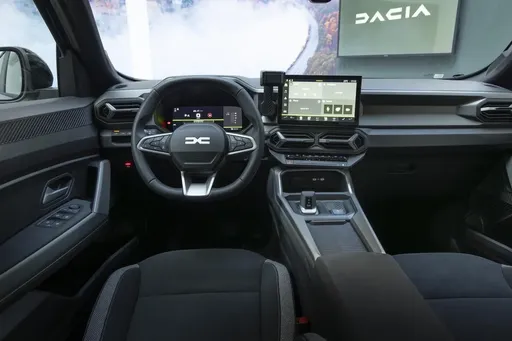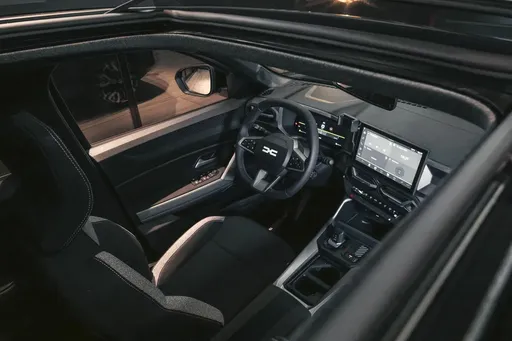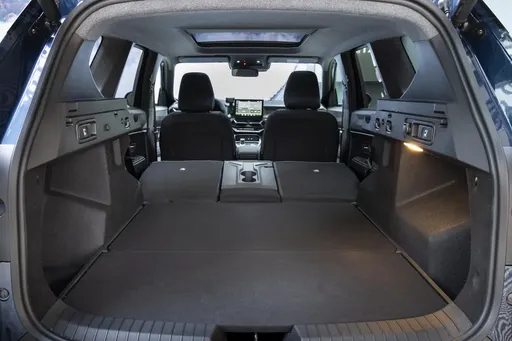VW Amarok vs Dacia Bigster – Differences & prices compared
Compare performance, boot space, consumption and price in one view.
Find out now: which car is the better choice for you – VW Amarok or Dacia Bigster?
The VW Amarok (Pickup) comes with a Diesel engine and Manuel or Automatic transmission. In comparison, the Dacia Bigster (SUV) features a Petrol MHEV or Full Hybrid engine with Manuel or Automatic transmission.
When it comes to boot capacity, the VW Amarok offers , while the Dacia Bigster provides 667 L – depending on how much space you need. If you’re looking for more power, decide whether the 240 HP of the VW Amarok or the 155 HP of the Dacia Bigster suits your needs better.
In terms of consumption, the values are 8.60 L per 100 km for the VW Amarok, and 4.70 L for the Dacia Bigster.
Price-wise, the VW Amarok starts at 43200 £, while the Dacia Bigster is available from 20600 £. Compare all the details and find out which model fits your lifestyle best!
VW Amarok
The VW Nutzfahrzeuge Amarok demonstrates a blend of rugged capability and refined design, making it a versatile choice for both work and leisure. Its robust build is complemented by a modern interior, offering comfort and practicality for drivers and passengers alike. On and off the road, the Amarok excels with a confident driving experience, catering to those who require both performance and style in one package.
detailsDacia Bigster
The Bigster is poised to redefine the SUV segment with its bold design and spacious interior, catering to the needs of both families and adventure seekers alike. Emphasizing sustainability and practicality, this model reflects a modern approach to automotive engineering, making it a compelling choice for environmentally conscious drivers. With its striking presence on the road, the Bigster not only captures attention but also embodies a new era of versatile mobility.
details @ media.renault.at
@ media.renault.at
 @ media.renault.at
@ media.renault.at
 @ media.renault.at
@ media.renault.at
 @ media.renault.at
@ media.renault.at
 @ media.renault.at
@ media.renault.at

|
|
|
|
|
Costs and Consumption |
|
|---|---|
|
Price
43200 - 64100 £
|
Price
20600 - 26200 £
|
|
Consumption L/100km
8.6 - 10.3 L
|
Consumption L/100km
4.7 - 6.1 L
|
|
Consumption kWh/100km
-
|
Consumption kWh/100km
-
|
|
Electric Range
-
|
Electric Range
-
|
|
Battery Capacity
-
|
Battery Capacity
-
|
|
co2
226 - 270 g/km
|
co2
106 - 137 g/km
|
|
Fuel tank capacity
80 L
|
Fuel tank capacity
50 - 55 L
|
Dimensions and Body |
|
|---|---|
|
Body Type
Pickup
|
Body Type
SUV
|
|
Seats
5
|
Seats
5
|
|
Doors
4
|
Doors
5
|
|
Curb weight
2262 - 2423 kg
|
Curb weight
1425 - 1503 kg
|
|
Trunk capacity
-
|
Trunk capacity
546 - 667 L
|
|
Length
5350 mm
|
Length
4570 mm
|
|
Width
1910 mm
|
Width
1813 mm
|
|
Height
1871 - 1884 mm
|
Height
1705 mm
|
|
Payload
883 - 983 kg
|
Payload
446 - 467 kg
|
Engine and Performance |
|
|---|---|
|
Engine Type
Diesel
|
Engine Type
Petrol MHEV, Full Hybrid
|
|
Transmission
Manuel, Automatic
|
Transmission
Manuel, Automatic
|
|
Transmission Detail
Manual Gearbox, Automatic Gearbox
|
Transmission Detail
Manual Gearbox, Automated Manual
|
|
Drive Type
All-Wheel Drive
|
Drive Type
All-Wheel Drive, Front-Wheel Drive
|
|
Power HP
170 - 240 HP
|
Power HP
130 - 155 HP
|
|
Acceleration 0-100km/h
8.8 - 11.6 s
|
Acceleration 0-100km/h
9.7 - 11.2 s
|
|
Max Speed
180 - 190 km/h
|
Max Speed
180 km/h
|
|
Torque
405 - 600 Nm
|
Torque
230 Nm
|
|
Number of Cylinders
4 - 6
|
Number of Cylinders
3 - 4
|
|
Power kW
125 - 177 kW
|
Power kW
96 - 115 kW
|
|
Engine capacity
1996 - 2993 cm3
|
Engine capacity
1199 - 1799 cm3
|
General |
|
|---|---|
|
Model Year
2023
|
Model Year
2025
|
|
CO2 Efficiency Class
G
|
CO2 Efficiency Class
E, D, C
|
|
Brand
VW
|
Brand
Dacia
|
VW Amarok
The Adventurous Spirit of the VW Amarok: A Pickup with Versatile Strength
In the world of pickup trucks, the VW Amarok stands tall as a symbol of power, durability, and innovation. Known for its impressive off-road capabilities and robust engineering, the Amarok continues to push the boundaries of what a pickup truck can achieve. The latest models further solidify its reputation with a blend of technical sophistication and rugged reliability.
Under the Hood: Exploring the Powertrain
The VW Amarok comes equipped with an array of impressive powertrain options, each catering to the needs of different drivers. The models feature a range of diesel engines starting from the efficient 2.0 TDI units producing either 170 HP or 205 HP, advancing to the formidable 3.0 V6 TDI engines delivering a remarkable 240 HP. These engines combine efficiency with power, offering a maximum speed ranging from 180 to 190 km/h.
A variety of transmission systems are available, including manual and automatic options, enabling a driving experience tailored to the driver's preferences. With all-wheel drive as a standard feature, the Amarok is designed to tackle any terrain, demonstrating exceptional off-road capabilities that make it a versatile choice for both urban and adventure-seeking drivers.
Efficiency and Performance: Balancing Power with Economy
The Amarok’s efficiency is complemented by its CO2 emission ratings, with the diesel engines supporting a CO2 efficiency class G rating and emissions ranging from 226 to 270 g/km. Fuel consumption varies between models, with the latest versions demonstrating impressive figures such as 8.6 L/100 km for the 170 HP models and around 10.1 - 10.3 L/100 km for the high-performing 240 HP models.
Design and Comfort: A Blend of Utility and Style
Beyond its mechanical prowess, the Amarok impresses with its design. This pickup measures 5,350 mm in length and 1,910 mm in width, providing a spacious and commanding presence on the road. The interior is equally generous, accommodating five passengers with ease within its well-appointed cabin that offers a comfortable and technologically equipped ambiance.
The Amarok is not just about performance; it embraces style and comfort with trims such as the 4MOTION, Life 4MOTION Automatik, and the distinctive Aventura 4MOTION Automatik. Each trim level offers unique features and specifications designed to meet diverse lifestyle needs and preferences.
Payload and Versatility: Built for Various Needs
When it comes to payload, the Amarok is designed for serious work. With a payload capacity ranging from 883 kg to 983 kg, it is equipped to handle a variety of cargo needs. This makes it an ideal choice for those in trades, agriculture, or any fields requiring reliable transport of heavy loads.
Final Thoughts: The Amarok Legacy
The VW Amarok continues to be a favorite in the pickup truck segment, combining efficiency, power, and versatility in an attractive package. Whether you need a vehicle for rugged terrain or everyday utility, the Amarok promises a reliable partner on the road. With its blend of modern technology and timeless design, it stands ready to meet the challenges of today’s driving environments.
Dacia Bigster
Introducing the Dacia Bigster: A Game Changer in the SUV Market
The Dacia Bigster is poised to redefine the landscape of compact SUVs with its striking design, innovative technologies, and a variety of powertrains that cater to a broad range of consumers. As the automotive world continues to shift towards sustainability without compromising performance, the Bigster stands out with its thoughtful engineering and modern features.
Striking Design and Practicality
From the moment you lay eyes on the Bigster, you can see that it was designed with purpose. Its robust silhouette, bold front fascia, and wide stance convey a sense of strength and stability. With dimensions of 4570 mm in length, 1813 mm in width, and standing 1705 mm tall, the Bigster offers a spacious cabin that comfortably accommodates five passengers. Coupled with a trunk capacity ranging from 546 to 667 liters, this SUV is as practical as it is stylish, making it perfect for both city driving and outdoor adventures.
Powerful and Efficient Engines
The Dacia Bigster offers a range of engine options designed to meet diverse consumer needs. The line-up includes two petrol MHEV variants: the TCe 130 and TCe 140, both available in front-wheel drive and all-wheel drive configurations. These engines not only deliver robust performance, with outputs between 130 and 140 HP, but also prioritize fuel efficiency, achieving consumption figures as low as 5.5 liters per 100 kilometers.
For those seeking an eco-friendlier option, the Bigster also features a Full Hybrid variant, the Hybrid 155, which offers an impressive 155 HP with a fuel efficiency rating of just 4.7 L/100 km. Additionally, the ECO-G 140 LPG variant allows for even more cost-effective driving without sacrificing power, catering especially to environmentally conscious consumers.
Innovative Technology Enhancements
The Dacia Bigster is equipped with an array of advanced technological features aimed at enhancing the driving experience. Its comprehensive infotainment system integrates a user-friendly interface with smartphone connectivity, ensuring that drivers can stay connected while on the road. Safety has also been prioritized, with features such as advanced driver assistance systems designed to keep both the driver and passengers secure.
Performance Meets Efficiency
Performance is a central theme in the Bigster's engineering. The SUV boasts a range of acceleration times, with the TCe 130 reaching 0-100 km/h in approximately 11.2 seconds and the TCe 140 doing so in a swift 9.8 seconds. The Hybrid model enhances this performance even further, offering a 0-100 km/h time of just 9.7 seconds. With a maximum speed of 180 km/h, the Bigster is not only capable but also thrilling to drive.
Comfort and Versatility
Inside, the Dacia Bigster emphasizes comfort and versatility with a roomy cabin that features high-quality materials and modern finishes. The SUV is designed with adjustable seating configurations and ample legroom, making it ideal for both daily commutes and longer journeys. It's also worth mentioning that the vehicle's curb weights range from 1425 kg to 1503 kg, optimized for performance and efficiency.
Conclusion: The Future of Driving with Dacia Bigster
The Dacia Bigster is more than just a new SUV; it represents a significant step forward in blending efficiency, performance, and practicality in an ever-evolving automotive landscape. With various engine options, advanced features, and a commitment to sustainability, it is clear that the Bigster is designed to meet the demands of modern drivers while appealing to a wide audience. Whether you are looking for a reliable city cruiser or a capable outdoor companion, the Dacia Bigster is set to deliver on all fronts.
The prices and data displayed are estimates based on German list prices and may vary by country. This information is not legally binding.
